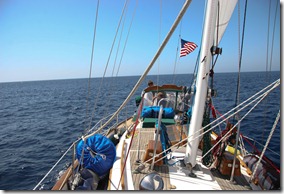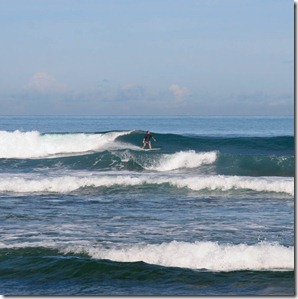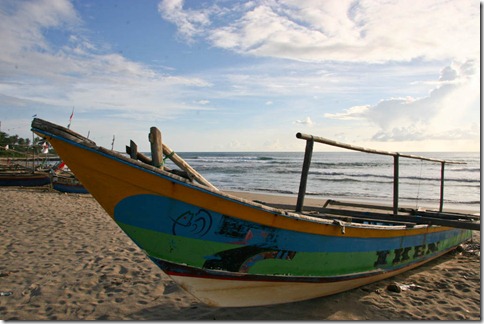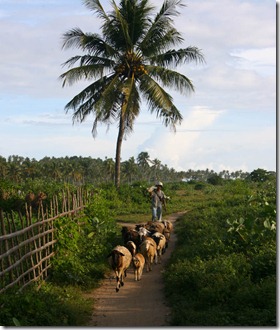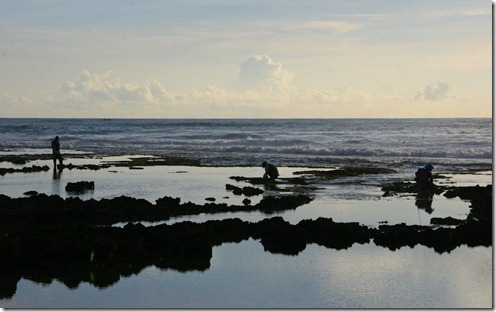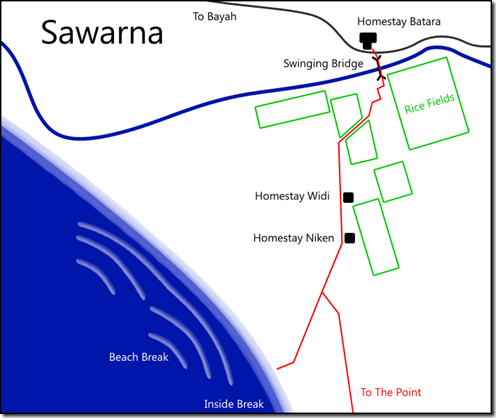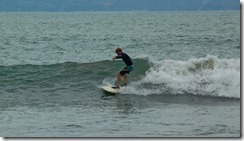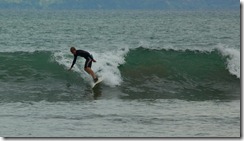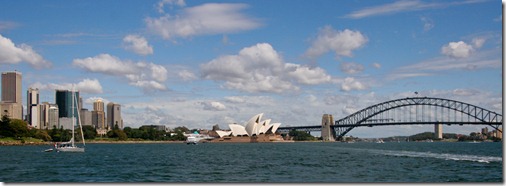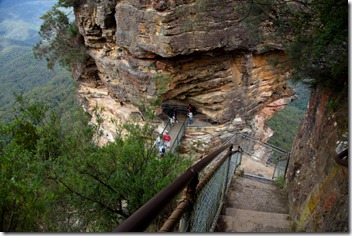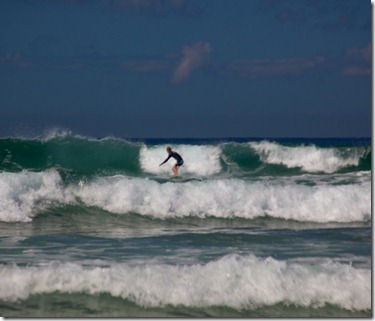 The morning after we arrived in Bahia de Tortugas we slept in, enjoying our newfound freedom from the watch schedule. Shortly after we got up we were surprised to find that Mexican Navy making rounds through the anchorage. I was immediately glad I had done our entry paperwork in Ensenada, and felt somewhat vindicated in ignoring the suggestions that we check in at Cabo. Thankfully the visit from the navy was brief and painless. Later that day Bill and I went spear fishing and brought back a Garibaldi and an Opal Eye for dinner. The winds were graceful and the waters were placid enough for us to even don our best short fins for snorkeling and take a dive. Before the day was out we put the outboard on the dinghy and took a tour of the bay in the dinghy, on the way we stopped by Jatimo, the small sloop that had pulled into the bay earlier in the day. The vessel was sailed by Jan and Ramona, also from the San Francisco Area. I had been looking forward to actually meeting other cruisers and becoming a part of the community so I invited them over for dinner. The next day, my birthday, we went to town and were shown around by Pedro from the fuel dock. He awkwardly sat around while we ate our lunch, and after showing us the way to internet cafe, I realized why and gave him a few dollars to leave us in peace. Truthfully he was pretty helpful and it was nice that he didn’t outright demand money for his services. We grabbed some groceries and headed back to the boat. Jen made a delicious meal of risotto and squash, and Ramona brought over some homemade hummus and a salad of fresh veggies, always a treat when you’ve been at sea for a bit. We had a great time sharing stories of our travels. They had a lot more than we did, having been doing this for over 20 years, and it was a pleasure to listen them and gain some wisdom. Friday we returned to the village for lunch with a view at La Palapa. This quaint little cantina came highly recommended, and it lived up to the expectations. For those who might be visiting, just walk east along the beach from the pier, go up the small hill to the right just past where the fishing boats launch. It’s a small white open air building. Bring your Spanish-English dictionary as there are no menus. Afterward we went for a long walk out to Punta de Kelp.
The morning after we arrived in Bahia de Tortugas we slept in, enjoying our newfound freedom from the watch schedule. Shortly after we got up we were surprised to find that Mexican Navy making rounds through the anchorage. I was immediately glad I had done our entry paperwork in Ensenada, and felt somewhat vindicated in ignoring the suggestions that we check in at Cabo. Thankfully the visit from the navy was brief and painless. Later that day Bill and I went spear fishing and brought back a Garibaldi and an Opal Eye for dinner. The winds were graceful and the waters were placid enough for us to even don our best short fins for snorkeling and take a dive. Before the day was out we put the outboard on the dinghy and took a tour of the bay in the dinghy, on the way we stopped by Jatimo, the small sloop that had pulled into the bay earlier in the day. The vessel was sailed by Jan and Ramona, also from the San Francisco Area. I had been looking forward to actually meeting other cruisers and becoming a part of the community so I invited them over for dinner. The next day, my birthday, we went to town and were shown around by Pedro from the fuel dock. He awkwardly sat around while we ate our lunch, and after showing us the way to internet cafe, I realized why and gave him a few dollars to leave us in peace. Truthfully he was pretty helpful and it was nice that he didn’t outright demand money for his services. We grabbed some groceries and headed back to the boat. Jen made a delicious meal of risotto and squash, and Ramona brought over some homemade hummus and a salad of fresh veggies, always a treat when you’ve been at sea for a bit. We had a great time sharing stories of our travels. They had a lot more than we did, having been doing this for over 20 years, and it was a pleasure to listen them and gain some wisdom. Friday we returned to the village for lunch with a view at La Palapa. This quaint little cantina came highly recommended, and it lived up to the expectations. For those who might be visiting, just walk east along the beach from the pier, go up the small hill to the right just past where the fishing boats launch. It’s a small white open air building. Bring your Spanish-English dictionary as there are no menus. Afterward we went for a long walk out to Punta de Kelp.
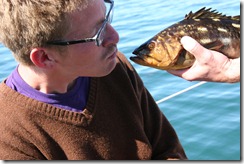 |
 |
After four nights we left Tortugas in the afternoon for an overnight sail to Bahia Asuncion. The trip was another fast, double reefed sail down the coast, and we had to heave to overnight to delay our arrival until morning. For the last few miles the wind clocked around and we were forced to motor into a strong headwind and current, approaching the anchorage at a crawl. We spent a day and a half in Asuncion. After a long upwind row we did some more diving and fishing. This time scoring a large Calico Bass on the rod (nice work Bill) and two lobsters. The lobsters are relatively easy to catch if you have a quick hand and a tight grip. Happily they have no claws with which to defend themselves. Unfortunately the kelp beds were so thick that stalking fish with the spear proved untenable.
The following evening we departed for Bahia Santa Maria. The trip was again uneventful. We sailed the whole way, only running the motor for the first few hours to charge the batteries. Our autopilot steered faithfully for the entire trip. We continue to have no luck trolling the hand line. I taught Bill to put a reef in the mainsail. We sailed upwind into Bahia Santa Maria to within a half mile of the anchorage. I wish I had some more poetical things to say about the trip, by suffice to say it was idyllic sailing.
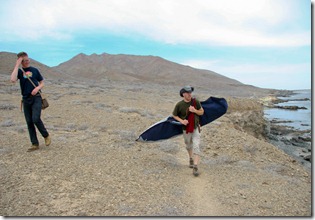 As soon as we had anchored in Bahia Santa Maria and had breakfast I was rallying the troops for a trip to shore to hike out to the point on the north side of the bay entrance. I had spied the telltale white spray of offshore winds on breaking waves and felt a burning desire to get some surf. To be honest my hopes were not all that high. We hadn’t been seeing much in the way of the south swell that would be required to make this spot break. Jen and Bill were both eager to get off the boat and hike around, so when breakfast was done we got the dinghy ready, packed up, and made the arduous paddle to shore in moderate winds. It was still nothing compared to the headwind Bill and I had fought to go fishing in Bahia Asuncion, where we only made it because I jumped overboard with fins to help propel us. Once on shore we discovered a convenient trail that took us the 1.5 miles out to the point. My excitement increased when
As soon as we had anchored in Bahia Santa Maria and had breakfast I was rallying the troops for a trip to shore to hike out to the point on the north side of the bay entrance. I had spied the telltale white spray of offshore winds on breaking waves and felt a burning desire to get some surf. To be honest my hopes were not all that high. We hadn’t been seeing much in the way of the south swell that would be required to make this spot break. Jen and Bill were both eager to get off the boat and hike around, so when breakfast was done we got the dinghy ready, packed up, and made the arduous paddle to shore in moderate winds. It was still nothing compared to the headwind Bill and I had fought to go fishing in Bahia Asuncion, where we only made it because I jumped overboard with fins to help propel us. Once on shore we discovered a convenient trail that took us the 1.5 miles out to the point. My excitement increased when 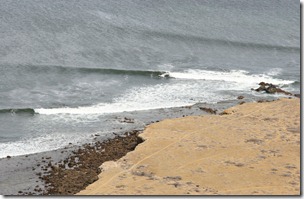 I found evidence of a surf camp, which although it was vacant at the moment was clearly still seeing active duty during the peak season. Just then I started running. I was driven forward from within as I watched a set of waves wrap beautifully around a point into a small cove. I couldn’t believe it, after months without surfing I was finally going to catch some waves. The session was great. The sets were infrequent, but the waves were waist to chest high with smooth curling faces. The break had alternating steep and gentle sections, and the rides were long, making it a great wave to mess around on with cutbacks and sweeping turns. I couldn’t help but smile at the fact I had sailed over 1300 miles to ride these waves.
I found evidence of a surf camp, which although it was vacant at the moment was clearly still seeing active duty during the peak season. Just then I started running. I was driven forward from within as I watched a set of waves wrap beautifully around a point into a small cove. I couldn’t believe it, after months without surfing I was finally going to catch some waves. The session was great. The sets were infrequent, but the waves were waist to chest high with smooth curling faces. The break had alternating steep and gentle sections, and the rides were long, making it a great wave to mess around on with cutbacks and sweeping turns. I couldn’t help but smile at the fact I had sailed over 1300 miles to ride these waves.
 |
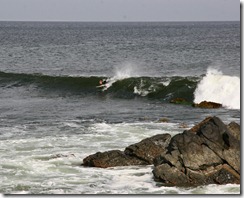 |
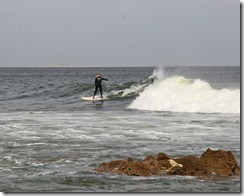 |
The following day Bill and I took it easy on the boat while Jen explored the “village.” It ended up being completely abandoned, although not apparently disused. We theorized that it was used in peak season by the fishermen. Jen was then stranded on shore for two hours while she tried vainly to hail us on the radio. What she didn’t realize is that our portable’s transmit function had died. Wondering where she was I scanned the shore with the binoculars, but couldn’t see a thing for the light of the setting sun bouncing off the water. Finally the wind let up enough for us to here here faint shouts over its steady roar, and I pulled to shore to pick her up. Sorry Jen.
Our last day at Santa Maria we made a second attempt at the surf. This time we were all armed with boards and we set out in the dinghy with the outboard. We zipped up the coast and put in at the panga landing beneath the surf camp. Unfortunately we made two critical errors. 1) I hadn’t properly relayed the plan to bill so he had no shoes for the quarter mile walk we had to make to the spot. 2) The tide was much lower now, so getting out meant walking over 50 yards of barnacle encrusted rocks with urchins lurking in the cracks. Bill, who already had massive blisters on each foot from the walk to the spot decided it was hopeless and waited on the beach. Jen, struggling with a nine foot board which had a mind of its own in the strong offshore wind was having trouble making it past the fields of urchins. After paddling around in the break for a few minutes watching the others struggle I realized we need a new approach. So with Bill wearing my too small sandals we headed back to the dinghy and simply motored out and dropped anchor. I felt like an idiot for not doing this in the first place with the swell so light. The break I had surfed two days earlier wasn’t showing at all, so we paddled around the corner to a totally hair-brained spot over shin deep boulders that jacked up steeply, and held up only for about 30 yards before smashing into the rocks on shore. After catching a few waves I shouted to Jen that you’d have to be crazy to try to surf this spot, as I paddled for another wave. It was a short but exciting ride in which you made a steep takeoff, doing everything you could to keep the nose from digging in and vaulting you bodily into the air, made a hard right and flew threw the hollow section over the shallow boulders, and then rode it out for a few seconds before bailing off to avoid the rocks. Fun!
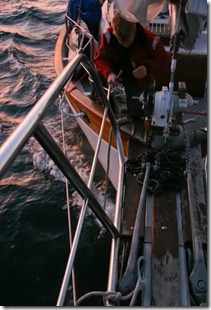 Back at the boat that evening we spent a few hours getting everything ready to go and then we were off to San Jose del Cabo. Ironically, after spending the last two days complaining about the constant, strong NNW wind that kept us rocking in the anchorage and fretting about our ground tackle (which held beautifully), the minute we got outside the cove the wind suddenly died. We had played it close with our schedule and had to been in Cabo in 48 hours to pick up my friend Steve there. So on went the motor and we proceeded in light and variable winds toward San Jose. But the gods of the sea and the wind smiled on us for a bit because after lunch the wind picked up. Having hoisted the staysail we were able to make 5+ knots close on the wind with Serenity steering herself dead on our best course for the Cabo Falso, the point at the south western tip of Baja. The sea was calm the wind was perfect and the weather warm. And just when it seemed things couldn’t get better we were surrounded by a massive pod of dolphins porpoising and breaching on all sides. They must have been feeding because moments later we got a strike on the hand line we’d been trolling on and off since San Diego with no luck. I watched as the line swung from side to side as the fish tried to fight. “Fish on” I shouted excitedly as I started hauling the line in. I’d been waiting to say that since I’d gotten the fishing gear in the first place.
Back at the boat that evening we spent a few hours getting everything ready to go and then we were off to San Jose del Cabo. Ironically, after spending the last two days complaining about the constant, strong NNW wind that kept us rocking in the anchorage and fretting about our ground tackle (which held beautifully), the minute we got outside the cove the wind suddenly died. We had played it close with our schedule and had to been in Cabo in 48 hours to pick up my friend Steve there. So on went the motor and we proceeded in light and variable winds toward San Jose. But the gods of the sea and the wind smiled on us for a bit because after lunch the wind picked up. Having hoisted the staysail we were able to make 5+ knots close on the wind with Serenity steering herself dead on our best course for the Cabo Falso, the point at the south western tip of Baja. The sea was calm the wind was perfect and the weather warm. And just when it seemed things couldn’t get better we were surrounded by a massive pod of dolphins porpoising and breaching on all sides. They must have been feeding because moments later we got a strike on the hand line we’d been trolling on and off since San Diego with no luck. I watched as the line swung from side to side as the fish tried to fight. “Fish on” I shouted excitedly as I started hauling the line in. I’d been waiting to say that since I’d gotten the fishing gear in the first place.  Bill came on deck to assist and deftly gaffed the fish and brought it on deck. It was a small but beautiful yellow fin tuna (I say small, but that’s because they get up to 400lbs, this one would feed us for several days). Blood poured all over the place as we tried various techniques to disable the fish (alcohol on the gills, bashing with the winch handle, and finally decapitation). Once it was finally subdued I quickly fell to filleting, knowing that the tuna’s meat would be degraded by the post mortem nervous system activity and I wanted to get some good sashimi out of it.
Bill came on deck to assist and deftly gaffed the fish and brought it on deck. It was a small but beautiful yellow fin tuna (I say small, but that’s because they get up to 400lbs, this one would feed us for several days). Blood poured all over the place as we tried various techniques to disable the fish (alcohol on the gills, bashing with the winch handle, and finally decapitation). Once it was finally subdued I quickly fell to filleting, knowing that the tuna’s meat would be degraded by the post mortem nervous system activity and I wanted to get some good sashimi out of it.
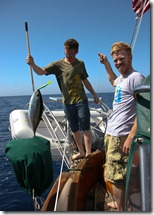 |
 |
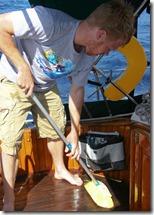 |
The wind failed at dusk, so after a dinner of tuna steaks and curry we motored on to San Jose del Cabo. We decided to stay at the Puerto Los Cabos rather than deal with the glitz and hubbub of Cabo San Lucas. The marina is nice enough, and a slip sans electricity was only $44 USD per night (50ft slip), but the place is a sort of half finished feel, with a lot of incompletely construction and vacant trash filled lots right next to manicured lawns. After checking in at the marina office we were off to the nearest American restaurant to get what had become for us the yardstick of civilization: cheeseburgers. Conveniently, the cheap slips are on the side of the marina where Tommy’s Barefoot Cantina is located. They have great food, including American fare, cold beer, a pool table, and free wifi. We had officially made it to Los Cabos.
Bahia Santa Maria Surf
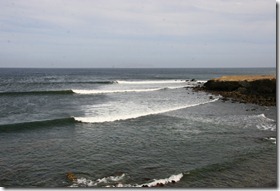 For those who may be interested, there are multiple spots along this patch of coast. Bahia Santa Maria is a large deepwater bay with ample space for boats. It is just WNW of Bahia Magdalena (Mag Bay). Check the cruising guides for more details on Bahia Santa Maria, but I will say this: there is nothing here. No diesel, no water, no mercado, and nobody selling fish. So come well supplied. The surf we saw is located on the inside of the northwest point that makes the entrance to Bahia Santa Maria (aka Santa Maria Cove). These spots all require a decent south swell, and high tide seems best. There were consistent off shore winds the whole time we were there (April 13-15 2011). I recommend a short board or fish, but you could make a longboard work. This isn’t a good beginner spot because if you don’t stay out on the shoulder you end up on the rocks and a small day means no day at all, not to mention you need to dodge the occasional rock in the lineup. Urchins and barnacles are an issue, so bring boots. There is a small protected landing spot just beneath the surf camp where the fishermen tie up. There are also trails further out the point and north toward the fishing camp/village where there are more landing spots. We were anchored at 24°46.276N 112°15.488W, 300 yards off the coast about three quarters of a mile south of the inlet to Santa Maria Lagoon. We went ashore on a patch of sand right where we were anchored. In any case, be careful where you leave your dinghy because of the tide. The hike out wasn’t too bad, but motoring out definitely saves time and arm strength. The second time out we just dropped the dinghy anchor just outside the break in 15 feet of water because the swell was small.
For those who may be interested, there are multiple spots along this patch of coast. Bahia Santa Maria is a large deepwater bay with ample space for boats. It is just WNW of Bahia Magdalena (Mag Bay). Check the cruising guides for more details on Bahia Santa Maria, but I will say this: there is nothing here. No diesel, no water, no mercado, and nobody selling fish. So come well supplied. The surf we saw is located on the inside of the northwest point that makes the entrance to Bahia Santa Maria (aka Santa Maria Cove). These spots all require a decent south swell, and high tide seems best. There were consistent off shore winds the whole time we were there (April 13-15 2011). I recommend a short board or fish, but you could make a longboard work. This isn’t a good beginner spot because if you don’t stay out on the shoulder you end up on the rocks and a small day means no day at all, not to mention you need to dodge the occasional rock in the lineup. Urchins and barnacles are an issue, so bring boots. There is a small protected landing spot just beneath the surf camp where the fishermen tie up. There are also trails further out the point and north toward the fishing camp/village where there are more landing spots. We were anchored at 24°46.276N 112°15.488W, 300 yards off the coast about three quarters of a mile south of the inlet to Santa Maria Lagoon. We went ashore on a patch of sand right where we were anchored. In any case, be careful where you leave your dinghy because of the tide. The hike out wasn’t too bad, but motoring out definitely saves time and arm strength. The second time out we just dropped the dinghy anchor just outside the break in 15 feet of water because the swell was small.

